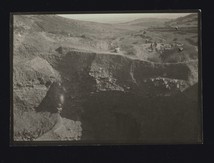Aegisthus: view high up looking out (from interior) over doorway towards the Panagia hill., 1922
Scope and Contents
The Aegisthus tomb is one of the three earliest tholoi known at Mycenae, dating to 1600-1500 BC. A. J. B. Wace and his team cleared the dromos, the doorway and two thirds of the chamber in 1922. (The remaining third of the tholos was deemed too dangerous to complete its clearance in 1923.)
The tomb receives its name in reference to its proximity to the ‘tomb of Clytemnestra’, equally imaginatively named in reference to Homeric epic. In the Odyssey Aegisthus features as the lover of queen Clytemnestra, her co-conspirator in the murder of her husband Agamemnon, and lastly as king of Mycenae.
Dates
- Creation: 1922
Creator
Extent
1 photographic print(s) (1 photograph)
Language of Materials
English
Physical Characteristics and Technical Requirements
H. 9.9 x W. 14.1 cm
Repository Details
Part of the University of Cambridge: Faculty of Classics Archives Repository
Faculty of Classics
Sidgwick Avenue
Cambridge CB3 9DA United Kingdom
+441223 335193
archives@classics.cam.ac.uk

